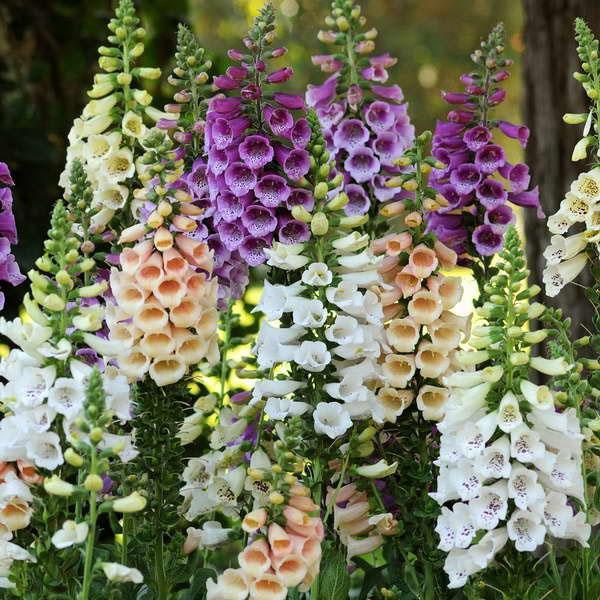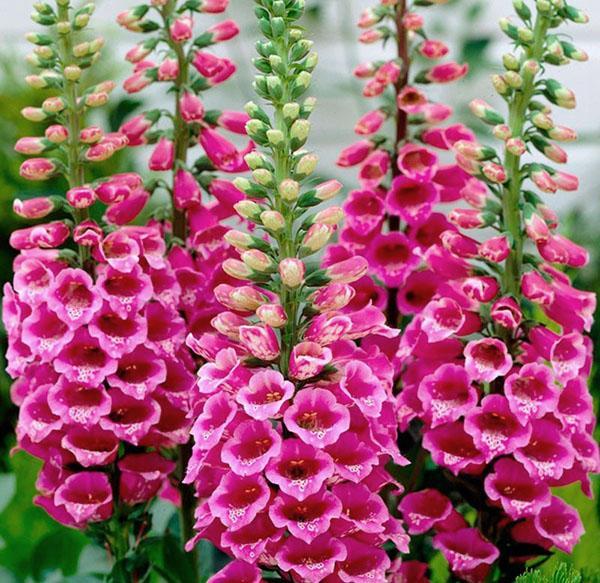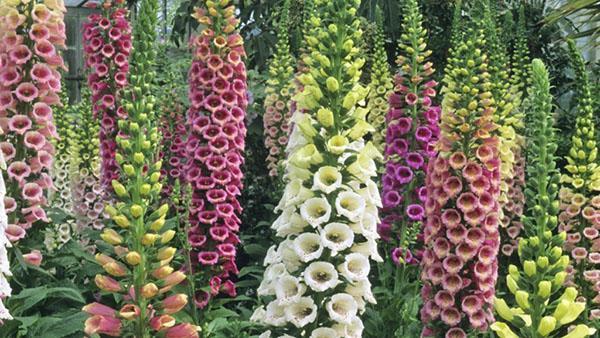The majestic species and varieties of foxglove are an amazing accent of the garden
 What kind of flowers do not bloom in the summer on the garden plot of a country house? But the types and varieties of foxglove cause unprecedented delight among true fans of home gardening. This unpretentious plant is often used as a marvelous vertical accent in flower beds. Throughout the summer, it is showered with bells on erect peduncles, which fit in an original way in any flower arrangement in the garden.
What kind of flowers do not bloom in the summer on the garden plot of a country house? But the types and varieties of foxglove cause unprecedented delight among true fans of home gardening. This unpretentious plant is often used as a marvelous vertical accent in flower beds. Throughout the summer, it is showered with bells on erect peduncles, which fit in an original way in any flower arrangement in the garden.

 Biologists count about 35 species and varieties of foxglove, which come in various sizes. Some of them grow only up to 30 cm, while others are considered real giants. These can be annual or perennial plants. Interestingly, before the buds appear on it, the flower does not look very attractive. But from the first days of June, it is completely transformed, throwing out an exquisite peduncle, decorated with asymmetric buds. They resemble a thimble in shape, which indicates the unusual name of the plant.
Biologists count about 35 species and varieties of foxglove, which come in various sizes. Some of them grow only up to 30 cm, while others are considered real giants. These can be annual or perennial plants. Interestingly, before the buds appear on it, the flower does not look very attractive. But from the first days of June, it is completely transformed, throwing out an exquisite peduncle, decorated with asymmetric buds. They resemble a thimble in shape, which indicates the unusual name of the plant.
In scientific circles, the flower is called "Digitalis" and is widely used in folk medicine to treat various ailments.
Meet: popular species and varieties of foxglove
 This vibrant plant has always been considered a welcome decoration for any garden, as its exquisite buds are painted in colors:
This vibrant plant has always been considered a welcome decoration for any garden, as its exquisite buds are painted in colors:
- red;
- white;
- pink;
- cream;
- purple;
- yellow.
Some examples of light colors are strewn with small blotches, which makes them truly bewitching. When choosing types of thimbles for a flower garden, one should take into account not only the color of the buds, but also the height of an adult plant.
The flower can be planted both in open areas of the garden and in shady alleys in the backyard.
A purple beauty for exotic lovers
 On the territory of summer cottages, you can often see a tall-growing beauty that amazes the imagination. Consider the pictures of foxglove purple to get to know her better.
On the territory of summer cottages, you can often see a tall-growing beauty that amazes the imagination. Consider the pictures of foxglove purple to get to know her better.
The plant is characterized by erect pubescent shoots, along which oval leaves grow on long petioles. The outer side is velvety, and the back is slightly pubescent.
Bells bloom in early summer and are:
- white;
- cream;
- pink;
- purple.
 Flowering ends in early September, therefore, as shown in the photo, purple foxglove decorates a flower bed at a summer cottage for a long time. In addition, there are many varieties of this cute flower. Here is some of them:
Flowering ends in early September, therefore, as shown in the photo, purple foxglove decorates a flower bed at a summer cottage for a long time. In addition, there are many varieties of this cute flower. Here is some of them:
- Shirley;
- "Pink Champagne";
- Fooksi;
- "Carousel";
- Peloric;
- Candy Montein;
- "Expelsior".
Scientists continue to work on new varieties and species of foxglove so that growers can decorate their summer cottages even better.
Yellow "Lady of Fire"
 Imagine a lady in a fluffy yellow dress. This is exactly what the yellow foxglove looks like from the side, covered with fiery buds.This flower belongs to tall plants, since it reaches a meter in height. Unlike others, its foliage and shoots are not pubescent. The buds only grow up to 2.5 cm in length. They are painted in a rich yellow color, only in isolated cases a small blotch of brown appears inside the bud.
Imagine a lady in a fluffy yellow dress. This is exactly what the yellow foxglove looks like from the side, covered with fiery buds.This flower belongs to tall plants, since it reaches a meter in height. Unlike others, its foliage and shoots are not pubescent. The buds only grow up to 2.5 cm in length. They are painted in a rich yellow color, only in isolated cases a small blotch of brown appears inside the bud.
 The perennial foxglove shown in the photo is a real proof of the greatness of this flower.
The perennial foxglove shown in the photo is a real proof of the greatness of this flower.
A spectacular flower with an unusual name
 Fans of tall flowers will appreciate this type of foxglove. She looks dignified in the flowerbed when she unfurls her graceful bells. Its name in Latin sounds especially impressive - "Digitalis ferruginea". In Russian it is known as rusty foxglove.
Fans of tall flowers will appreciate this type of foxglove. She looks dignified in the flowerbed when she unfurls her graceful bells. Its name in Latin sounds especially impressive - "Digitalis ferruginea". In Russian it is known as rusty foxglove.
 This cute herb grows to a height of 1.2 meters. It is a perennial, therefore it is quite suitable for landscape design of a summer cottage. Its erect stem, most often glabrous, emerges from the rosette of basal leaves. In the photo of rusty foxglove, you can clearly see that the rest of the plates also differ in size. It all depends on their location on the stem. The buds of the plant are a bit like orchids with different colors:
This cute herb grows to a height of 1.2 meters. It is a perennial, therefore it is quite suitable for landscape design of a summer cottage. Its erect stem, most often glabrous, emerges from the rosette of basal leaves. In the photo of rusty foxglove, you can clearly see that the rest of the plates also differ in size. It all depends on their location on the stem. The buds of the plant are a bit like orchids with different colors:
- light yellow;
- with a pinkish tint;
- yellow-gray;
- golden brown.
The highlight of the flower is its elegant corolla with sinewy patterns in red, purple or brownish.
Due to the variety of tones, the plant is widely used to decorate stylish street flower beds at their summer cottage.
Serious lady - foxglove woolly
 This perennial plant grows up to 80 cm tall. Basal leaves have an ovoid oblong shape, the length of which is about 12 cm. Stem plates (lanceolate) are much smaller, which gives the plant an unusual color.
This perennial plant grows up to 80 cm tall. Basal leaves have an ovoid oblong shape, the length of which is about 12 cm. Stem plates (lanceolate) are much smaller, which gives the plant an unusual color.
 In the photo of the woolly foxglove, dense pyramidal inflorescences are clearly visible. All of them are abundantly covered with pile. Brown-yellow buds grow on dense glandular pedicels. The first ones bloom in June, the latter in August.
In the photo of the woolly foxglove, dense pyramidal inflorescences are clearly visible. All of them are abundantly covered with pile. Brown-yellow buds grow on dense glandular pedicels. The first ones bloom in June, the latter in August.
Since the plant has a number of useful properties, it is grown in specialized fields as a medicinal raw material.
The stately decoration of the flower bed is the large-flowered foxglove
 Despite its high growth - 120 cm, this flower is considered undersized. The main reason is the large buds that attract special attention. Outside, they are painted in pale yellow, almost white. And inside you can see a brown scattering of pretty "freckles" that turn the flower into a work of art. The large-flowered foxglove shown in the photo is a true confirmation of this masterpiece of creation.
Despite its high growth - 120 cm, this flower is considered undersized. The main reason is the large buds that attract special attention. Outside, they are painted in pale yellow, almost white. And inside you can see a brown scattering of pretty "freckles" that turn the flower into a work of art. The large-flowered foxglove shown in the photo is a true confirmation of this masterpiece of creation.
Some flower lovers know this flower under the following names: fox glove, thimble grass and fairy hat.
To date, many varieties of this pretentious beauty are known:
- Foxglove "Purple Giant".

- "Apricot" (grows up to 1.4 m, color - apricot).

- Alba.

- "Yellow".
- "Dot".
- "Snow Thimble".
 Each of them is distinguished by its unique beauty. Even the giant white foxglove is striking in its consummation. After all, from the inside, it is painted in a scattering of various shades.
Each of them is distinguished by its unique beauty. Even the giant white foxglove is striking in its consummation. After all, from the inside, it is painted in a scattering of various shades.
 In addition, the unique structure of the bud contributes to the pollination of the plant. The stamens are located in the upper part, therefore, when an insect touches them, pollen falls on their backs. They, in turn, penetrating deep into the flower, pollinate the artsy plant. Over time, boxes filled with seeds form on it. Biologists say there are several thousand of them. Thus, the foxglove reproduces successfully and continues to decorate our extraordinary planet.
In addition, the unique structure of the bud contributes to the pollination of the plant. The stamens are located in the upper part, therefore, when an insect touches them, pollen falls on their backs. They, in turn, penetrating deep into the flower, pollinate the artsy plant. Over time, boxes filled with seeds form on it. Biologists say there are several thousand of them. Thus, the foxglove reproduces successfully and continues to decorate our extraordinary planet.